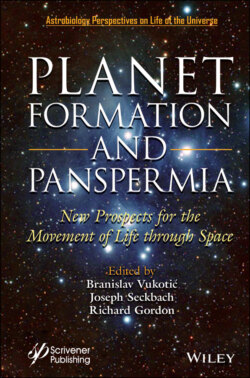Читать книгу Planet Formation and Panspermia - Группа авторов - Страница 18
2.4 Conclusions
ОглавлениеI have briefly outlined some of the reasons that should suggest a careful examination of the feasibility of interstellar panspermia. If transfer of microscopic life across stellar systems has been an active mechanism over the course of galactic history, the implications cannot be overemphasized. Just to name the most obvious repercussion: if the exchange of dust and rocks had a role in disseminating not only biological building blocks but also living organisms across the Galaxy, the whole question of the typical timescale of abiogenesis would have to be completely reconsidered (and, therefore, prior assumptions on the frequency of life beyond Earth should be changed accordingly). Also, while the detection of life outside the Solar System would be a momentous discovery, the mere possibility that its origin and distribution can be correlated among nearby stellar systems would drastically alter the broader consequences of such a finding.
For this reason, more attention should be given in the future to the possibility of lithopanspermia as a viable mechanism over interstellar distances. Ideally, one would want to have strong reasons to either admit or refute the possibility of interstellar panspermia before evaluating the results of future observations, so as to choose the right prior when interpreting possible biosignatures detections. From a theoretical point of view, this should imply a careful examination of effective dynamical routes (and of travel timescales) for the transfer of life-carrying rocks across space, including various factors that have been neglected in previous studies, such as the mixing of stellar orbits, or the enhanced capture cross-section due to inhomogeneities in the stellar distribution. Also, as mentioned previously, the result of such analyses should inform the construction of future models of the GHZ, where the interstellar transfer of life should be included as an additional process, in competition with catastrophic astrophysical events.
In parallel with such theoretical work, independent experimental studies would be crucial to assess the feasibility of the various processes involved. This should include, for example, continuing and expanding the investigation of the survivability of organisms in deep space, conducting in vivo experiments of hypervelocity impacts, and examining pristine samples of rocks from the early epochs of the Solar System. There are also good chances of observing more interstellar asteroids in the Solar System, which would result in refined estimates of the amount of material that can be transferred between stars. This would also open the exciting prospect of investigating the composition of rocks of extrasolar provenance, either remotely, through spectroscopic studies, or, in the more distant future, in situ, with dedicated space probes. All in all, evaluating the plausibility of interstellar panspermia should be one of the top priorities of both theoretical and experimental astrobiology in the near future.
